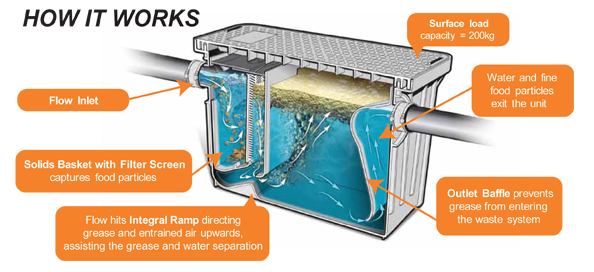Any organization that handles any type of food should install a grease trap or interceptor. Even small food service providers like coffee shops who serve products with dairy should install a grease trap or interceptor to keep FOG from going down the drain. An organization will be required to install a grease trap or interceptor if a side sewer has a visually evident accumulation of fat, oil or grease. Refer to the latest Uniform Plumbing Code (available at your public library) for sizing criteria.
They vary in cost, depending on size and application and can start as low as few hundred to thousands of dollars. Please contact a certified plumber in the area for prices.
If your food service organization handles food and washes dishes, you most likely need to install a grease trap or interceptor. The decision will be based on the type of use and agreed upon by the engineer and county personnel.
Every organization that handles food of any sort – from a coffee shop serving milk and other dairy products to a restaurant preparing deep-fried foods – is most likely discharging FOG. All food service providers are responsible for installing a device to keep FOG from entering their side sewer and the public sewer line.
If your organization handles any food that contains fat, oil and grease, you might eventually encounter a maintenance problem such as a blockage in the building sewer line. A blockage can create a sewer backup situation and ultimately a potential health problem for the organization. If the problem is in the building sewer line, then the organization is directly responsible for paying for the cleanup costs and property damage. An organization may also be required to close for business until an inspector certifies all health issues are resolved.
If the blockage is in the public sewer main and local Water and Sewer Company can verify that the practices of a specific organization has caused the blockage, then that organization may have to pay for the public cleanup costs, property damage and public sewer maintenance costs to relieve the blockage. The organization will also be required to install a grease trap or interceptor or upgrade an existing device to intercept food and FOG.
A grease trap or interceptor should be regularly maintained to meet the 25% Rule – no more than 25%, by volume, of the trap or interceptor should accumulate of food and FOG. If more than 25% of food and FOG accumulate in the trap or interceptor, it is more likely to not be working properly and discharging food and FOG into your building sewer and the public sewer system. Exceptions to the 25% Rule are for devices that are designed to retain more than 25% FOG and will be specifically stated in the manufacturers specification.
Each organization should work out a specific cleaning schedule that is right for their business. Some organizations will need to clean their trap or interceptor more often than others. It is important to remember that implementing kitchen best management practices, such as scraping your plates, pots, and pans, will reduce the amount of food and FOG that discharge into a trap or interceptor, therefore decreasing the frequency of cleaning.
| Grease trap maintenance is usually performed by maintenance staff or companies like Just Drains. Grease interceptor (GI) maintenance, which is usually performed by permitted haulers or recyclers, consists of removing the entire volume (liquids and solids) from the GI and properly disposing of the material in accordance with all federal, state, and/or local laws. When performed properly and at the appropriate frequency, grease interceptor and trap maintenance can greatly reduce the discharge of FOG into the wastewater collection system. The required maintenance frequency for grease interceptors and traps depends greatly on the amount of FOG a facility generates as well as any best management practices (BMPs) that the organization implements to reduce the FOG discharged into its sanitary sewer system. In many cases, an organization that implements BMPs will realize financial benefit through a reduction in their required grease interceptor and trap maintenance frequency. As maintenance Just Drains’ Drain Shield in a drip application for commercial environments or monthly cap full in residential applications will treat your grease trap, grease interceptor or kitchen sink flowing and odor free. |
